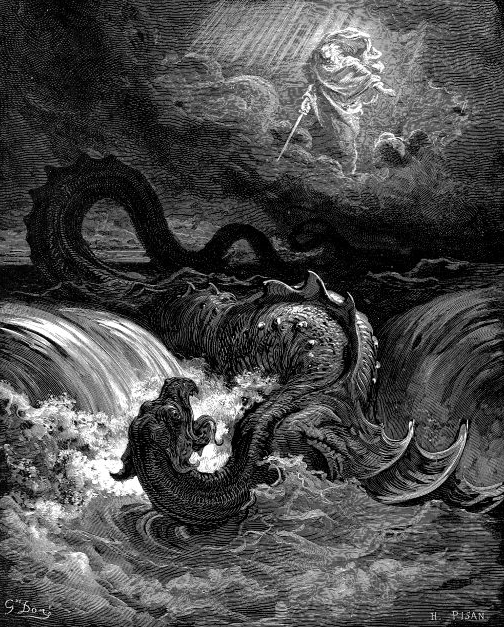[featured-image single_newwindow=”false”]Sparky, the Arizona State Sun Devils mascot. Taken by James Santelli, Neon Tommy. September 24, 2011. (Wikipedia)[/featured-image]
Instead of avoiding the public spotlight in order to hide his schemes, the devil prefers being the center of attention.
Screwtape gives us the basic summary of this week’s tactic:
I do not think you will have much difficulty in keeping the patient in the dark. The fact that ‘devils’ are predominately comic figures in the modern imagination will help you. If any faint suspicion of your existence begins to arise in his mind, suggest to him a picture of something in red tights, and persuade him that since he cannot believe in that (it is an old textbook method of confusing them) he therefore cannot believe in you. (32)
Everyone has seem them. Red tights. Pointy horns. Pitchfork. And a devilish smile. If that is who the devil is, I certainly would not believe in him! And yet, this type of “devil” is all over the place. Let’s take the Arizona Sun Devils as a prime example (see picture above).
“Sparky”
On November 8, 1946, the student body of the Arizona State University voted 819 to 196 to change the school mascot from the Bulldog to a “Sun Devil.” Two years later, alumnus and Disney illustrator Bert Anthony designed “Sparky.” Ever since then “Sparky” has become one of the most popular and well-known college mascots. Arizona State University even updated “Sparky” and asked all “students, alumni, sports fans, faculty and staff to share their thoughts regarding the updated mascot costume that will make its debut at this fall’s first football game” (ASU).
The reasoning for the update is as follows:
An updated contemporary version of the character will be used in comic books, children’s books, animated films, and on merchandise and apparel designed to reach younger audiences (ASU).
Those involved with this campaign most likely have no clue what they are doing and are doing it with complete honesty. Unfortunately, whether they realize it or not, they have been duped by the devil and he is enjoying every second of it. The devil would love if “younger audiences” would associate the devil with this very comical, almost lovable, figure. I am sure there are even stuffed animals of “Sparky” that you can buy.
If the devil we talk about in the Christian religion is just another version of “Sparky,” who would believe in his real existence, or who would be afraid of him? The devil is smart. So many of us have these false images of the devil roaming around in our mind and when someone brings up “spiritual warfare,” it is no wonder why many would think it is silly and unnecessary. I could beat “Sparky” with a simple punch in the nose. I don’t need to wage war against him!
The Dragon
The version of the devil we see in Scripture is much more threatening than “Sparky.” For example, the “serpent” in the book of Genesis is a much more fearsome foe than a “garden snake” that we typically see. Here is Scott Hahn’s take on the subject:
We’re all used to the storybook Bible image of the long, thin snake slithering around the apple tree. But we might have to change our visual image of this scene.
The Hebrew word used to describe the “serpent,” nahash, implies something much more deadly.
Throughout the Old Testament nahash is used to refer to powerful, even gigantic, evil creatures. Isaiah calls the nahash a sea dragon, the great Leviathan (see Isaiah 27:1). Job also uses nahash to depict terrible sea monsters (see Job 26:13).
This is clearly the image the Book of Revelation has in mind when it describes “a huge red dragon” in the heavens, “the huge dragon, the ancient serpent, who is called the Devil and Satan, who deceived the whole world” (see Revelation 12:3,9).
The Church, of course, has always interpreted the serpent in Genesis 3 as Satan, the Devil in slithering form (see Catechism, nos. 391-395). So we know, as readers, something that Adam probably didn’t know – that this encounter with the serpent was a test against evil, a battle for the soul of mankind.
But we need to see what Adam saw. Once we appreciate that the serpent was a lot more than a little garden-variety snake, we begin to understand why Adam failed in his duties to “guard” his wife and Eden (see Genesis 2:15). (St. Paul Center for Biblical Theology, emphasis added)
Personally, I am much more frightened of a “sea monster” or a “dragon” then cuddly, smiling “Sparky.”
Takeaway Point #7: Let us remember that the devil is a fearsome foe and that is why we must always be on guard. He exists and we must put on the Armor of God to be protected from his deadly arrows. We must have a healthy fear of Satan, one that realizes he is deadly, but also knows that Christ is much more powerful than him. God is always the victor!
Read the Entire Series
- The Enemy’s Tactic #6: How Satan Encourages us to be Charitable to People we Do Not Know
- The Enemy’s Tactic #5: How the Devil Tricks us into Believing that Death Will Never Come
- The Enemy’s Tactic #4: Stripping the Liturgy
- The Enemy’s Tactic #3: Daily Pinpricks
- The Enemy’s Tactic #2: Focusing on Sinners in the Church
- The Enemy’s Tactic #1: The Loss of Reason
- In the Enemy’s Camp: An In-depth Look at the Tactics of the Devil
————-
***If you would like to follow-along reading the The Screwtape Letters, I suggest to purchase your own copy of C.S. Lewis’ The Screwtape Letters. If you don’t like reading, I highly suggest buying the dramatization of the letters by Focus on the Family, called The Screwtape Letters: First Ever Full-cast Dramatization of the Diabolical Classic (Radio Theatre)
. It features Andy Serkis, who played Gollum in The Lord of the Rings and The Hobbit and is well produced.


